Getting ready for the eclipse and testing one of the imaging setups today. Took a single DSLR shot of a couple sunspots. Sun spot 2648 is on the left, 2645 is the most prominent group closer to center, with 2644 on the right.
Getting ready for the eclipse and testing one of the imaging setups today. Took a single DSLR shot of a couple sunspots. Sun spot 2648 is on the left, 2645 is the most prominent group closer to center, with 2644 on the right.
Just getting around to publishing some pictures from the 2016 Black Forest Star Party at Cherry Springs State Park in Pennsylvania. What a great stretch of weather for PA! The nights weren’t the darkest or most transparent (SQM 21.4-21.5) nights I’ve had at CSSP but clear and a little murky was way better than the alternative after driving up from Knoxville TN. Had a great time with some old friends and good to see some old club members too.
Had a few imaging problems related to dithering and settle time / settle criteria that made me lose a fair number of shots but I got two images which, I have to be honest, I’m not real pleased with. They are however, more challenging objects, but would have come out better had the sky conditions been closer to the SQM 21.8 that I’ve seen before at CSSP. But, we take whatever quality of clear sky we can get during a pre-planned star party!
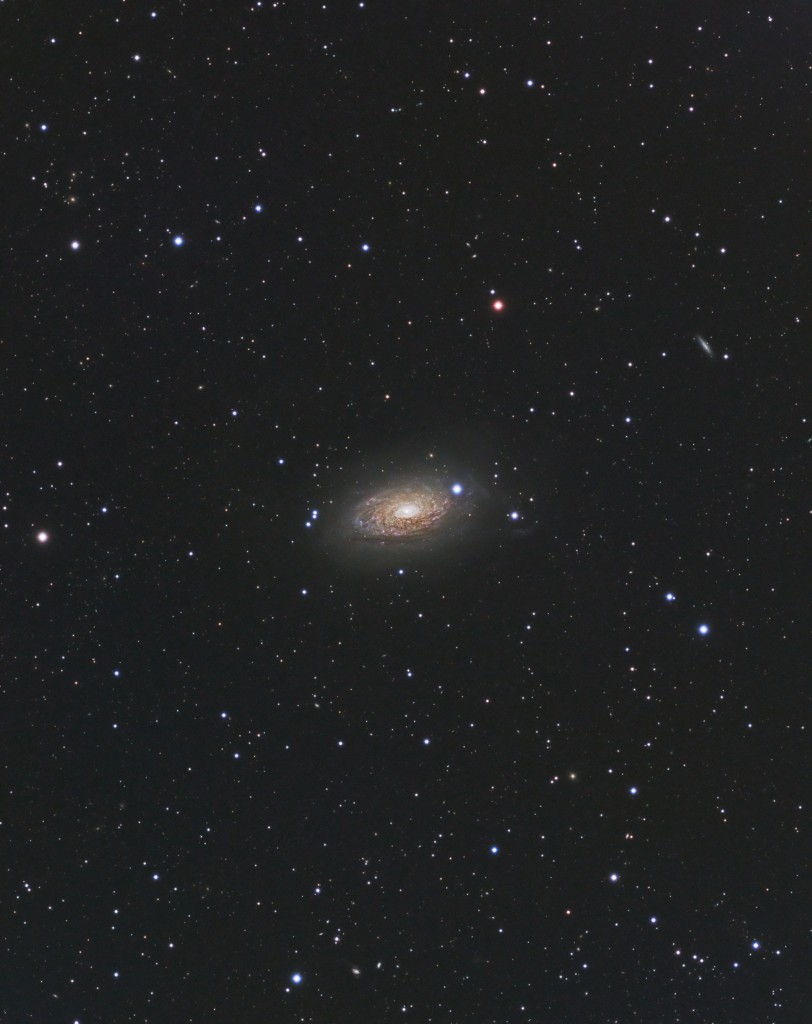
M63 – AP900GTO, Stellarvue SVQ-100, Apogee Ascent A694, Baader LRGB Filters, 4.5 Hour Total Exposure Time.
Messier 63 (also known as M63, NGC 5055, or the Sunflower Galaxy) is a spiral galaxy in the constellation Canes Venatici consisting of a central disc surrounded by many short spiral arm segments. M63 is part of the M51 Group, a group of galaxies that also includes M51 (the ‘Whirlpool Galaxy’). M63 is an active galaxy with a LINER nucleus.[3]
M63 was discovered by Pierre Méchain on June 14, 1779.[4] The galaxy was then listed by Charles Messier as object 63 in the Messier Catalogue.
In the mid-19th century, Lord Rosse identified spiral structures within the galaxy, making this one of the first galaxies in which such structure was identified.[4]
In 1971, a supernova with a magnitude of 11.8 appeared in one of the arms of M63.
Information courtesy of Wikipedia.
Friday night was fantastic without a cloud to be seen. Saturday night was less pristine with a lot of thin cloud moving through. I thought we had some clearing later but a lot of the images from Sat night showed very inconsistent background values which leads me to believe we had thin stuff moving through all night. Still, how many clear nights can you ask for? It was a great TSSP and looking forward to the Fall Star Party.
SQM measurements topped out around 21.3 on Friday night and 21.4 on Saturday night.
On April 1st through April 3rd Pickett State Park, a newly designated IDA Dark Sky Site, held its first Astronomy Weekend Star Party. We were clouded out Friday night but clouds on Saturday finally yielded to clear skies albeit with some very gusty winds until the wee hours of the morning.
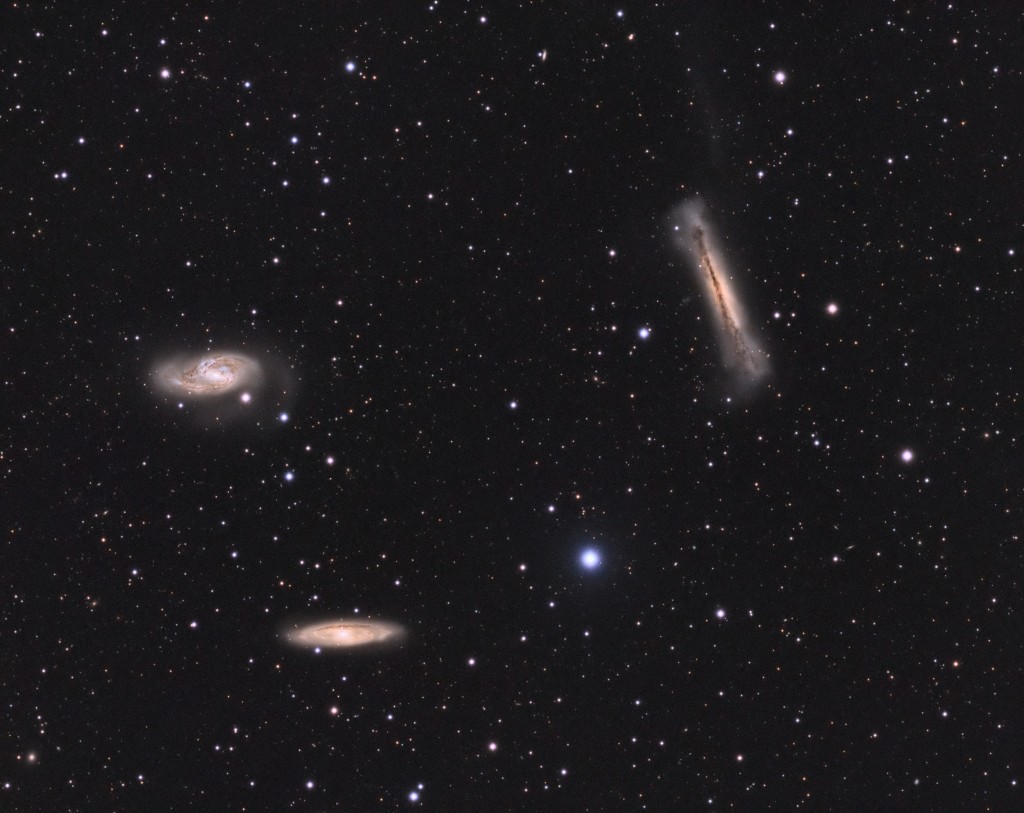
The Leo Triplet – M65, M66, & NGC 3628
Stellarvue SVQ 100, Apogee Ascent A694, AP900GTO Mount, Exposure 4 hours, SQM 21.48
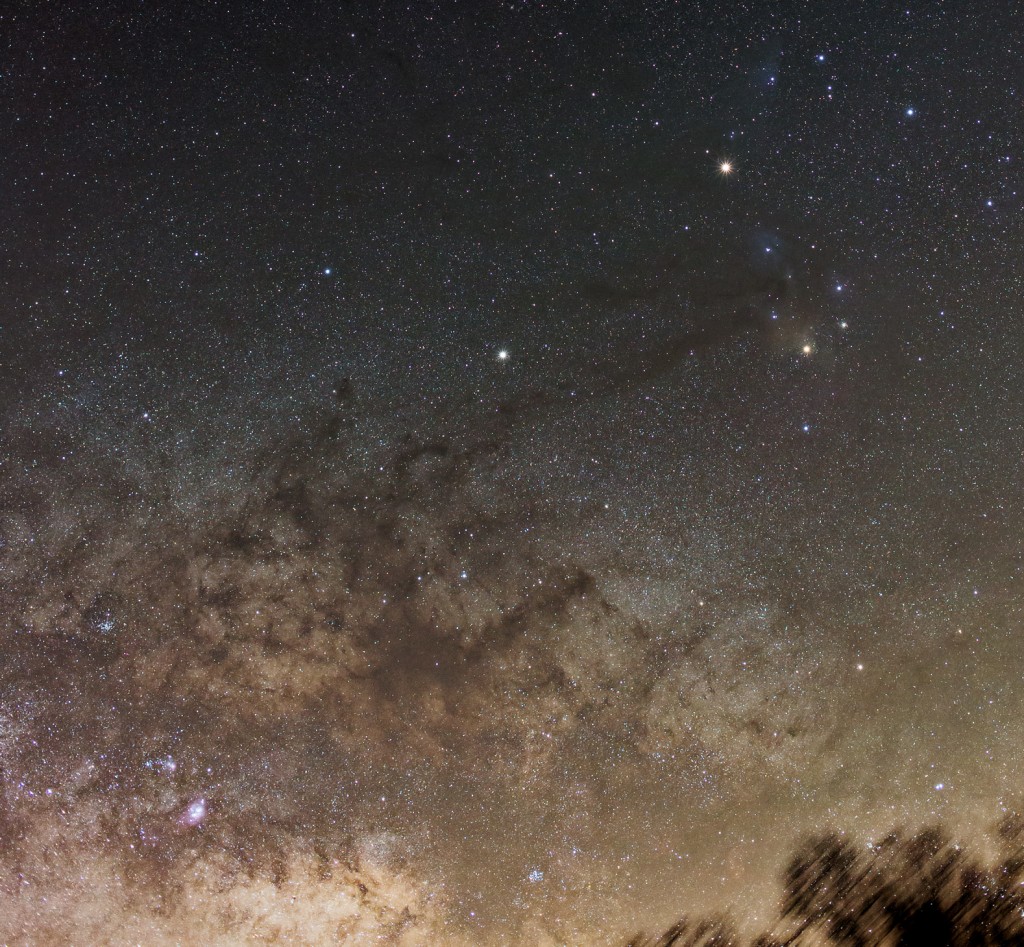
Rho Ophiuchi Cloud Complex stretching down to the Lagoon Nebula Canon 6D with 40mm f/4 ISO 1600 4min single exposure
Earlier this year (2015) Pickett / Pogue State Park was named a Silver Tier IDA dark site. I haven’t made it up for a night of astrophotography yet but have been wanting to visit the area and scope it out before lugging all the equipment up there for the first time. On Sunday my wife, the dogs, and I made a visit up to hike the short trail to the Pogue Canyon Overlook. The trail head is connected to the parking lot that adjoins the astronomy field at the Pogue SNA. First off, finding the place wasn’t difficult BUT google maps does not have current satellite imagery from there so I couldn’t pinpoint it easily. The address given didn’t seem to match up with anything in the imagery. So, to make it a little easier, here is an image of the location:
I’ve been interested in Pickett / Pogue for a while since it appears to be one of the darkest places in Tennessee and is located only 1:40 from my home. Here are a few light pollution maps showing where it is in relationship to sources of light pollution:
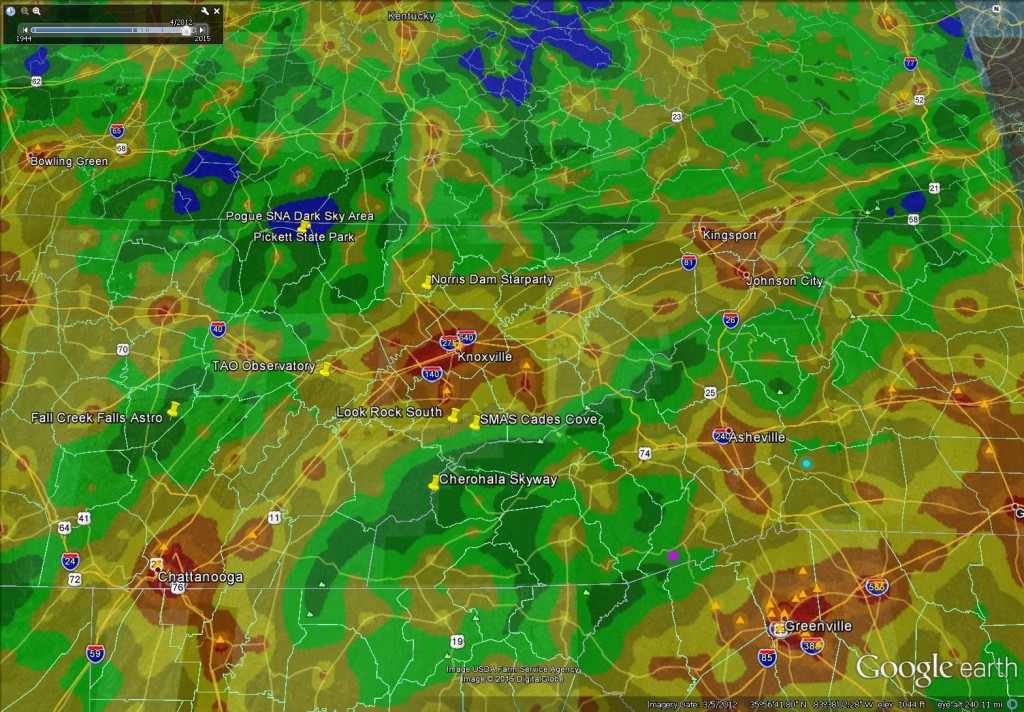
Pickett / Pogue East TN Light Pollution with some notable astronomy observing locations highlighted.
I also wanted to share a few photos from the site to show you all what to expect when you arrive at the site:
A little bit of side information that might be of interest as it contains SQM measurements, photos, and upcoming event information:
Pickett – Pogue Dark Sky Press Release
Pickett – Pogue Internation Dark Sky Assoc. Application
Picket – Pogue Lighting Plan – Dark Sky Friendly Lighting
Don’t forget, the Fall Star Gaze is happening 9/19/2015 at this location! I’d love to see you there but I’m tied up and can’t make it. Hope to make it out under the stars there another time.
This was my first visit to Fall Creek Falls for the 2015 Tennessee Fall Star Gaze. It’s a casual get together held at a clearing within walking distance from the Inn. The site is reasonably dark measuring 21.42+ on Friday and 21.31 on Saturday after some thundershowers upped the humidity level. Both nights were good so long as you were prepared for dew.
I spent both nights gathering data on SH2-155; the Cave Nebula. It’s a fairly dark object and I’d like more than the 4.5 hours of exposure time I got on it but a couple technical issues coupled with the early moon rise limited my time….

SH2-155
AP130EDT f/8 reduced to f/6
AP900GTO3 Mount
Apogee Ascent A694 CCD
9x10min Lum
7x10min Red
6x10min Green
5x10min Blue
S 155, also known as the Cave Nebula, Sh2-155 or Caldwell 9, is a dim and very diffuse bright nebula within a larger nebula complex containing emission, reflection, and dark nebulosity. It is located in the constellation Cepheus.
Visually it is a difficult object, but with adequate exposure, makes a striking image. The nebula gets its name Cave Nebula from the dark lane at the eastern side abutting the brightest curve of emission nebulosity which gives the appearance of a deep cave when seen through a telescope visually.
Information Courtesy of Wikipedia
This was my first time to Fall Creek Falls and I was not sure what to expect in terms of amenities. For those of you considering going: Restrooms are a 1000+ ft walk from the site. There are no restrooms at the field, nor is there any power, water, etc. The only things available at the site are trashcans. The Inn, as I mentioned before, offers restrooms, along with buffet meals, vending machines, and accommodations on the lake.
It ended up being a gorgeous night at Norris. The MW was clearly visible and seeing looked reasonably good just based on the naked eye twinkle criteria.
I was able to gather a paltry 3x20min of O[III] and 2x20min of S[II] data on M8 (The Lagoon Nebula) to complete a tricolor Hubble Pallet image before it moved behind a tree….
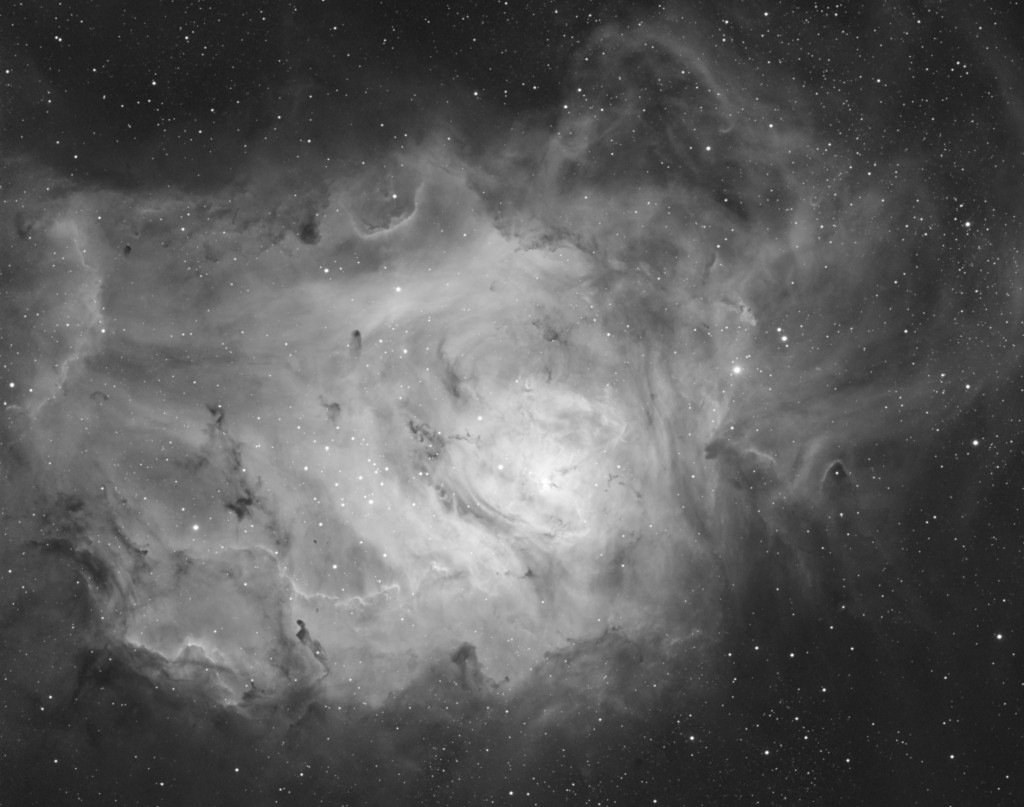
M8 – The Lagoon
Atlas EQ-G
Stellarvue SVQ100, Apogee Ascent A694
8x20min through a Baader Ha 7nm filter.
The Lagoon Nebula (catalogued as Messier 8 or M8, and as NGC 6523) is a giant interstellar cloud in the constellation Sagittarius. It is classified as an emission nebula and as a H II region.
The Lagoon Nebula was discovered by Giovanni Hodierna before 1654[4] and is one of only two star-forming nebulae faintly visible to the naked eye from mid-northern latitudes. Seen with binoculars, it appears as a distinct oval cloudlike patch with a definite core. In the foreground is the open cluster NGC 6530.
From Wikipedia, the free encyclopedia
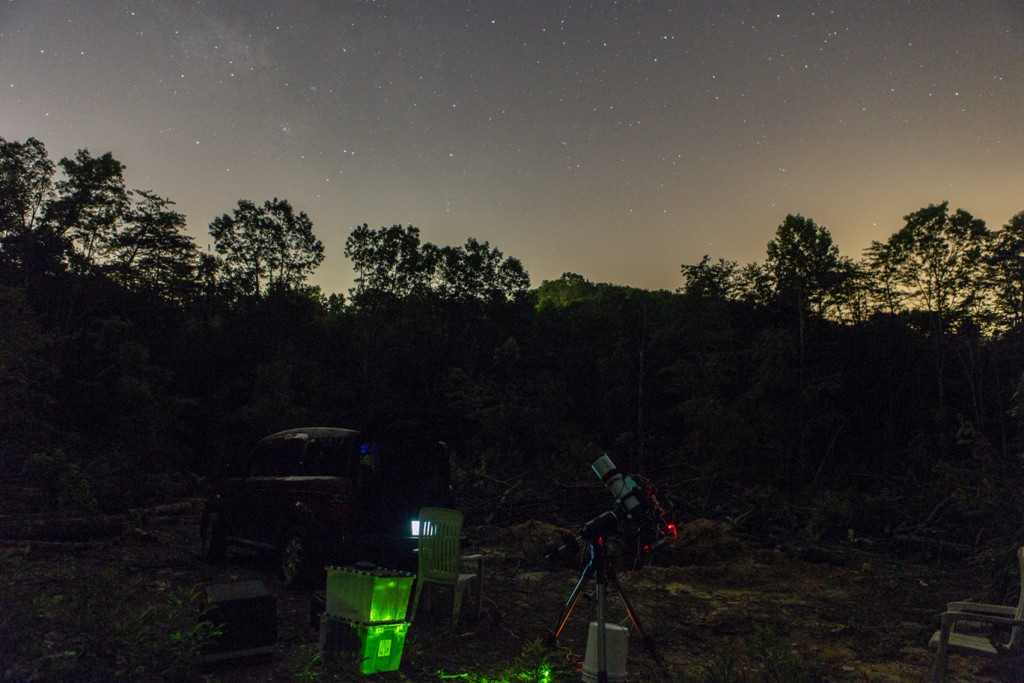
Future home observatory site looking south. The faint open cluster appearing on the left is M7 in Scorpius. Taken with a Canon 6D and 24-70mm f/2.8 at 24mm and f/4 for 20 sec at 1600 ISO.
Conditions were decent up until some clouds rolled in around 3:00am. There was a lot of lightning flashing to the north so I packed up a little early and headed back to the house. SQM measurements started around 20.2 but improved to 20.4 with a max of 20.5 around 1:00am.
The light pollution domes seen in the image are Oak Ridge to the south west (right side) and Clinton to the east/south east (left side).